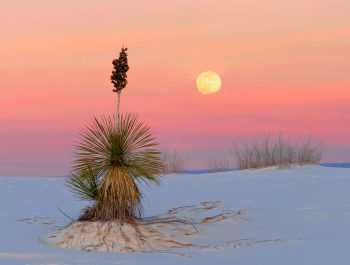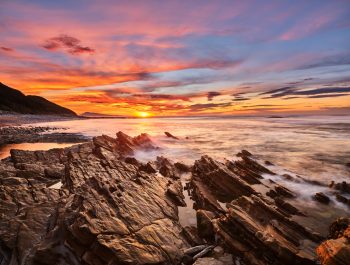A Never-Ending Quest for Higher Image Quality (IQ)
Part 2 – Camera Technology
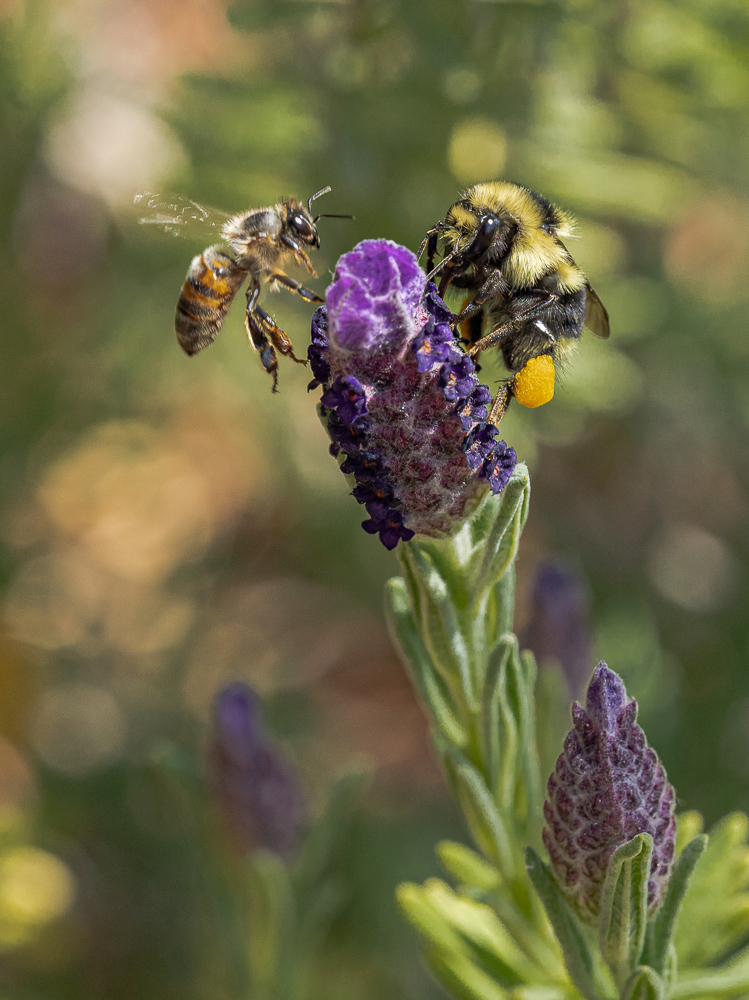
This is the second of a three-part series on IQ, a concept often used by serious photographers to define the essence if not the characteristics of what goes into producing great classic photographic images. It relates to equipment rather than to concept or technique and is loosely based on the premise that better tools expand the artist’s ability to produce compelling artworks. Part One explored the impact of the recently introduced Sony A7r M4 camera, which set in motion a flood of new higher resolution lenses needed to fully exploit the M4’s 61 MP sensor, a resolution level that overlaps with the larger sensors used in medium format cameras.
For most of my life, I associated the acronym “IQ” with intelligence quotient tests used as a means of predicting raw intellectual potential of young students. It wasn’t until about a dozen years ago that I heard that acronym applied to the potential productivity of a then-new Phase One medium format 40 MP digital back, though the term “Image Quality” may have been used earlier. Today, many photographers read IQ evaluations of new cameras and lenses to decide which ones to buy. Yet, this term may mean different things to different people.
So, there are a few things to iron out before going any further. It is a given that many great images excel on the basis of individual creativity and don’t necessarily use or require great technical capability. Also, there are a number of technical features in cameras and lenses, including image stabilization, that contribute to overall image quality but are not part of how the Camera Industry uses this term. For the purposes of this article, IQ is the quantifiable measure of how well various digital camera sensors and lenses enable greater image quality by minimizing specific physical recording constraints.
For digital sensors, the performance factors to be controlled are:
Resolution – for given sensor size, relates to pixel density and capture of fine detail
Noise Generation – caused by heat build-up from high pixel densities and using high ISO’s
Dynamic Range – how many exposure zones in f-stop equivalents a sensor can handle between
pure white and pure black beyond which no detail information exists
Color Accuracy – Fidelity of color recording, usually related to sampling levels & sensor design
Color Gamut – the amount of color information a sensor produces, e.g. 16-bit vs 14-bit
Sensor Uniformity – the extent to which quality control can eliminate errant pixels & flaws
(Two of these, resolution and color accuracy are dependent on the lenses used, and may not reach their potential if those lenses are not designed to fully exploit that potential.)
All of these are measurable factors that affect objective image quality, the limits imposed on the photographer. Photography has always been an activity with trade-offs:
- Increase sensitivity (use higher ISO’s), and also amplify noise.
- Increase depth of field with smaller lens openings to get more in sharp focus, and also diminish resolution because of diffraction.
And so on.
The challenge has always been to develop new technology that reduces one degrading factor without adversely affecting another. However, from my perspective of practicing photography for almost 70 years, the last five years of technical advances seem to have achieved the impossible dream.
Twelve years ago, increasing resolution beyond 20 MP in a 35mm size sensor meant living with increased noise because, with standard Bayer arrays, more pixels meant smaller photo-sites, thereby increasing heat buildup and consequently more noise. At that time, some photographers, including me, chose to add medium format cameras and lenses to their gear. Since then, DSLR and Mirrorless Camera sensor technology have steadily improved. In 2017 Sony introduced its M3 version of the A7r series. It offered 42 MP with the ability to shoot at ISO 1600 with low noise, superior color accuracy, and a dynamic range of 14.5 stops. Consequently, I sold my medium format equipment and shot exclusively with Sony mirrorless cameras.
Does this mean that medium format with larger sensors lost its edge? Not at all. Phase One continues to push the envelope with state-of-the-art equipment. However, I have no need for 100 MP or 150 MP sensors; and MF systems have much more limited selections of lenses at the very short and ultra-long ends of the focal length range. A normal lens for an MF camera is typically 85mm long compared with 50mm for 35mm format. Proportionately, a super-telephoto lens for MF would have a 1000mm focal length compared with 600mm for 35mm format. As there is little demand for this type of lens the manufacturer’s best course is not to make them.
The fact is that larger format cameras are better suited to commercial photography and advertising, for which the equipment is often used in indoor controlled environments, and where high image quality is one of the highest priorities. The significantly higher costs of larger format cameras and lenses are as much due to small production runs as it is to product size. But, larger format users generally can afford and justify much larger equipment investments, and they are more likely to rely on a narrow range of lenses from a moderate wide-angle to short telephoto to cover their subjects.
In comparison, 35mm format equipment is better suited to outdoor photography, where lower weight and size, faster handling, and a wide range of focal lengths are needed. As the market for this equipment is larger than for larger formats (particularly when including users of slightly smaller formats like C-size and Micro Four-Thirds), it is no coincidence that this segment drives most of the technological advances in the camera industry. Some of these advances then spill over into medium format. However, the two major formats maintained distinctly different niches until Canon’s 51 MP 5D DSLR, and now Sony’s 61 MP A7r M4 mirrorless camera was launched. However, most of the differences in use and capability remain in the two formats.
Current MF sensor resolutions range from 50MP to 150MP with well-controlled noise. Despite the higher pixel density of the Sony A7 M4 sensor, noise is also well controlled. This A7r M4 also offers outstanding continuous-tracking autofocus with 10 fps multi-frame shooting, making it well suited for photographing wildlife as well as landscapes, a versatility that medium format doesn’t have.
A full 15-stop dynamic range also places this camera in the company of the better MF cameras which had been one of the key IQ advantages of MF over 35mm format. Because of Sony’s latest sensor design improvements, high color accuracy is also no longer the exclusive domain of MF. However, one of MF’s advantages still holds. Most MF cameras produce full 16-bit files, whereas no full-frame (35mm) format does at this time. Also, while Sony’s latest full-frame camera captures in 14-bit files which are internally processed to 16-bit output files, the consensus is that these are not as good as MF 16 bit files.
In general, today’s MF sensors and top 35mm format sensors are of high quality and produce extremely few blemishes and artifacts. So, this is less of consideration now. Some of this may just be due to the fact that Sony makes many of the sensors for other brands besides Sony, including the new Phase One 150 MP back. This Phase One Sony sensor gives every indication that it is a larger version of the same design used in Sony’s A7r M4 camera.
Interestingly enough, with the present state of technological achievement, we’re beginning to hear chatter to the effect of “Do we really need such large digital files?”. Or, “Why do we need so many complicated features?”. Admittedly, even though Sony is one of a handful of technologically advanced companies, they still struggle to develop an easier more intuitive menu system. On balance though, there is tremendous value in the advanced capabilities and options available in today’s cameras. In many cases, they offer ways around the historic limitations and make it easy to nail some images that were almost impossible to capture a few years back.
Two of my most recent photography projects come to mind in which my Sony A7r M4 helped produce much better images than what I made with previous camera models.
Challenge #1:
Capture a close-up image of fast-moving bees with sufficient depth of field (DOF) to provide sharp detail of the entire insect, but also capture a colorful de-focused background with beautiful bokeh. To achieve the brilliance and detail that this scene called for, the lens that I wanted to use for this task was a Voigtlander 110mm APO-Lanthar Macro lens
The setting was a small garden that was largely in shade. However, the Lavender blooms were illuminated by full mid-day sun. About 12 Bumble Bees were gathering nectar and pollen that they mixed with saliva to form a paste which they then attached to the hairs on their hind legs until there was enough to carry back to their nest. They visited each bloom for two to five seconds before zooming off to the next one.
The Solution:
The use of a tripod was out of the question. My camera had to be mobile and responsive to short-lived opportunities. This, plus the need for sharp detail of insects that were in almost constant motion, meant setting a shutter speed of at least 1/500s. To allow reasonable DOF, a smaller lens opening no larger than F8 would also be necessary. This meant using a higher ISO from 800 to 1600. I chose ISO 800 to avoid noise build-up. Setting the camera on Aperture Preferred mode, the ambient light resulted in a shutter speed of 1/640 s.
Critical focus was the largest single challenge. From experience in these types of situations, I knew that autofocus was unreliable because the abundant surrounding detail would fool the camera AF. Besides, my macro lens is manual focus. Either way, it was impossible to change focus quickly and accurately moving from one part of the scene to another. The only solution was to pick the healthiest looking bloom and wait for the bees to come to it. Then I had to decide how much DOF I needed to get a bee totally in focus, and adjust my distance from the bloom to achieve that minimum required DOF.
The only problem was that the bee would be too small in the image to achieve the impact of a macro or at least a closeup image unless I did extensive cropping. That’s where the A7r M4’s 61 MP sensor came in. The final image is only about 25 percent of the original size. But, that’s still 15MP, sufficient for making a 13×19 inch print.
After adjusting all of the settings, I crouched and waited. Within a minute, a Bumble Bee landed on my bloom, and I made the following image.
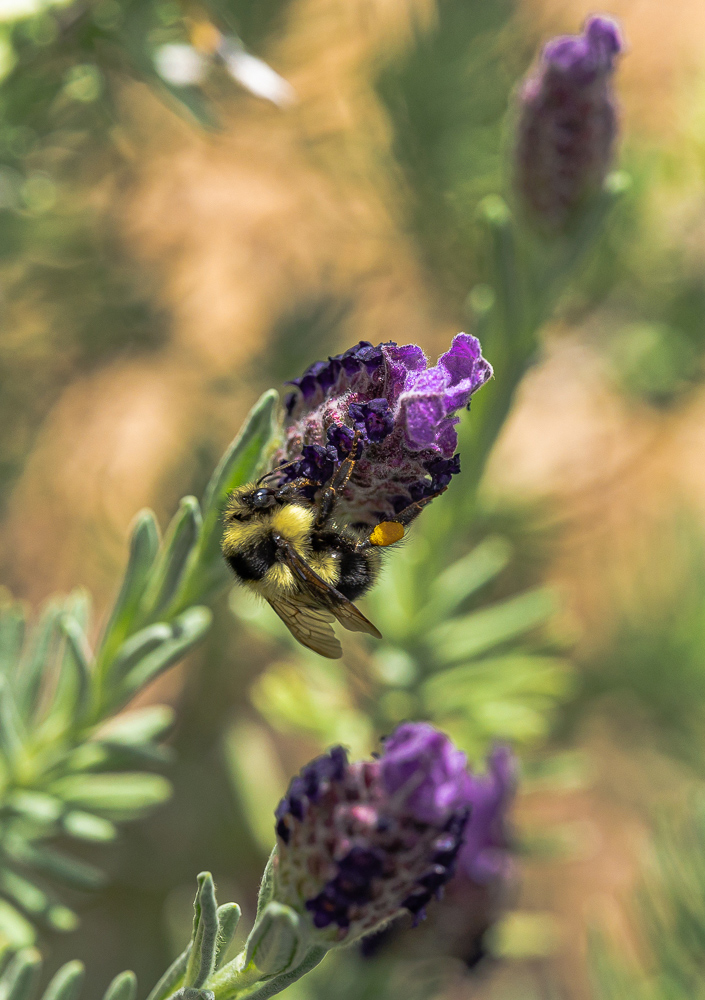
However, this image is the final edit. The original edit reveals the extensive cropping necessary to produce the desired impact.
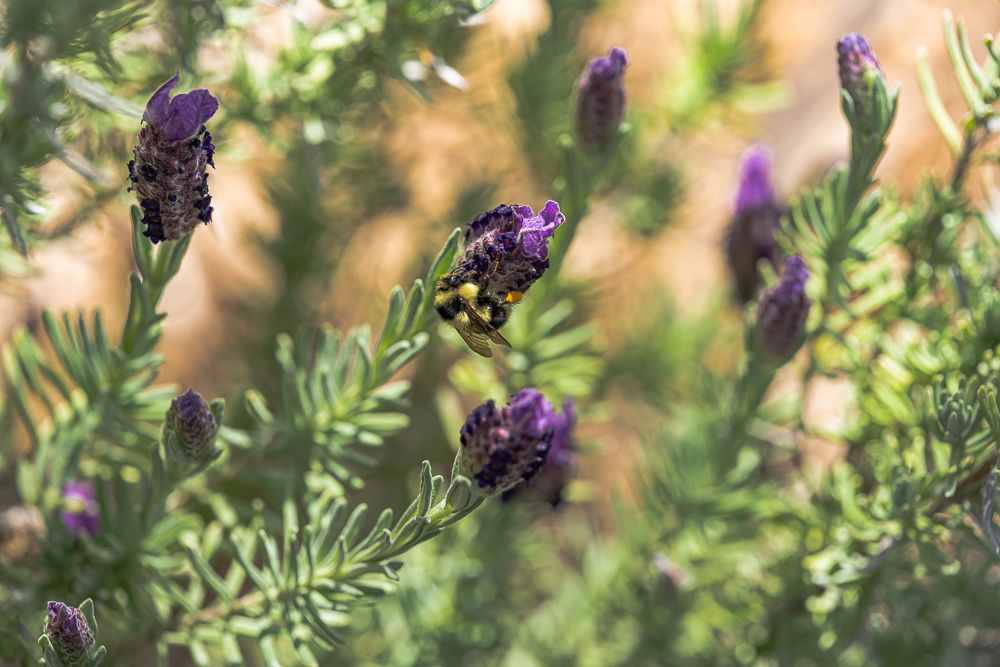
Another ten minutes resulted in a few more quality images, including the one below.
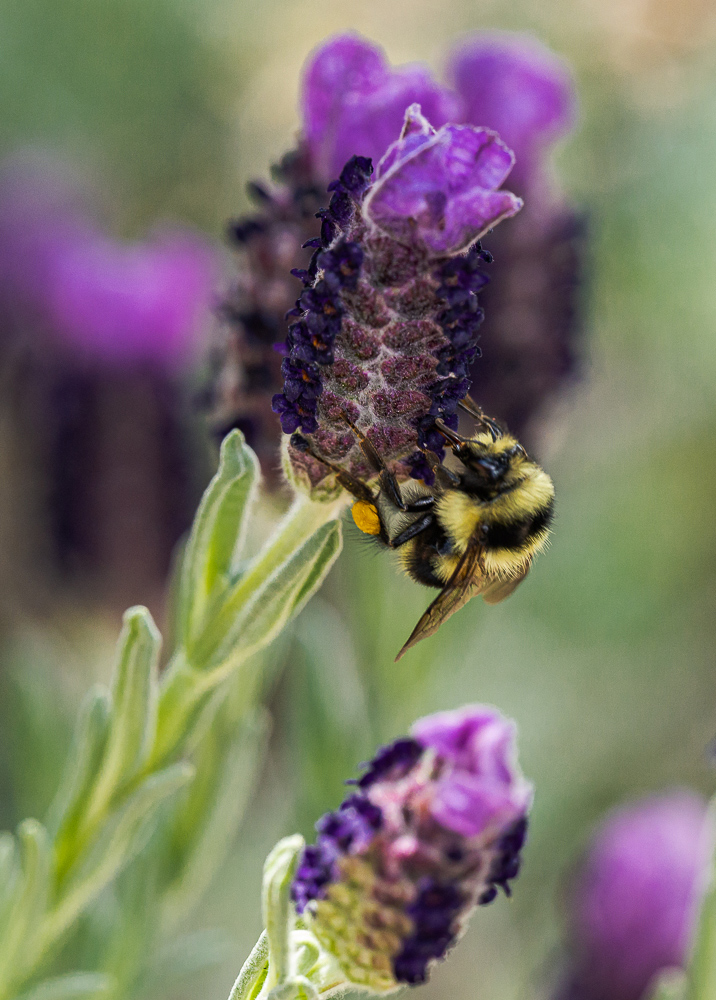
Again, the original uncropped image size is shown for comparison.
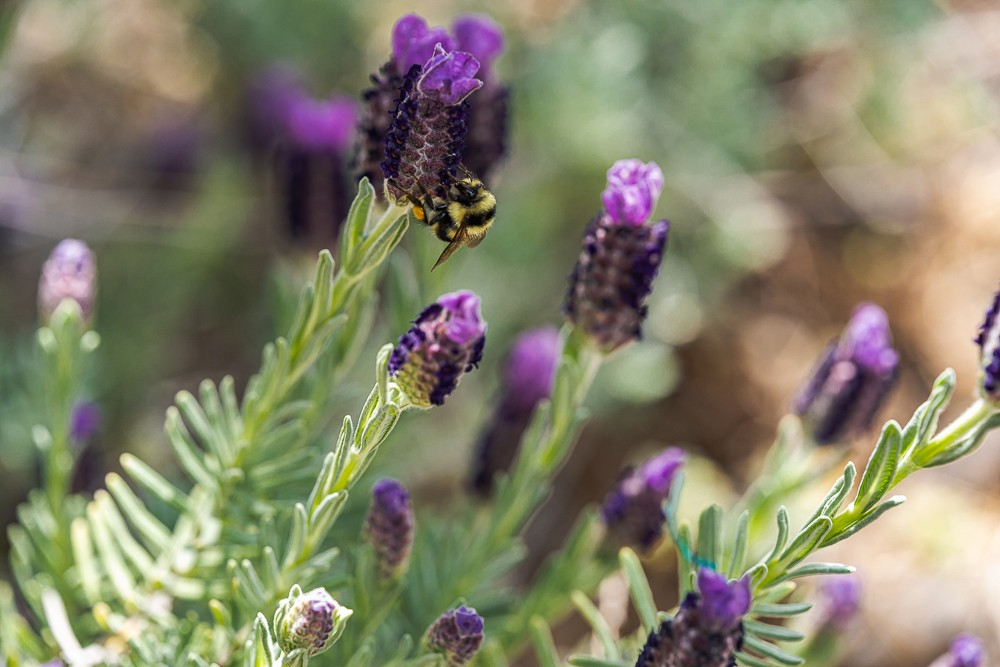
I returned the next day to continue shooting and found that the scene had gotten more complicated. The Bumble Bees had returned. But, a dozen Honey Bees had also joined the party. Tracking all of these insects and activities to find one good spot and moment was now more complex and chaotic.
Generally, bees try to avoid blooms where another bee is working. Occasionally, they move too fast to be sure. Rarely, there is a little harmless squabble between bees from the same hive. As a rule, the Honey Bees try to avoid direct conflict with the much larger Bumble Bees. But, misjudgments do happen, and this created the potential for an even better image, though it would be more difficult to capture it.
I took a few shots to get my timing back. Then, out of the corner of my left eye, I saw a Honey Bee headed toward the same bloom that my Bumble Bee was on, but didn’t see it on the other side until just before it was about to land. I shot this image at the critical moment at which the Honey Bee reversed course and “hightailed it out of Dodge”.

(Insert caption: “On a Collision Course“)
Once again, about three-quarters of this image has been cropped.
Sometimes you get lucky. But, usually, that’s a matter of doing enough preparation to be ready for rare moments, and also of having the right equipment. The Sony A7r M4 made the preceding images possible in the following ways:
- Lots of pixels to work with, and discard if necessary
- 15 stops of Dynamic Range to keep shadow detail and avoid highlight burnout
- Very low noise even at ISO 1250
- A really effective focus peaking program to judge the zone of sharpness
- 5-axis image stabilization to preserve critical sharpness without using a tripod
- Viewfinder resolution of 5,760,000 dots showing action in sharp detail.
In the creation of these images, the first three of the above “success” factors are also the first three IQ factors most commonly used to rate sensor quality. They affect every image that is made with this and any other digital camera. The other three are valuable in helping to make high-quality action images, but less so when the scene is static.
Challenge # 2
While at Bosque del Apache National Wildlife Reserve last Fall, one of my objectives was to capture in detail the majesty of a Sandhill Crane soaring overhead. Though many cranes flew above me, not one was close enough to fill up the frame, even with an 840mm focal length. There was one large crane that was surrounded by snow geese. However, they were not in the same focus plane.
The Solution
The only thing I could do was to take the shot anyway, and crop to just the crane. Once again, the crop was severe; but, the resulting image was good enough to produce a substantial print.
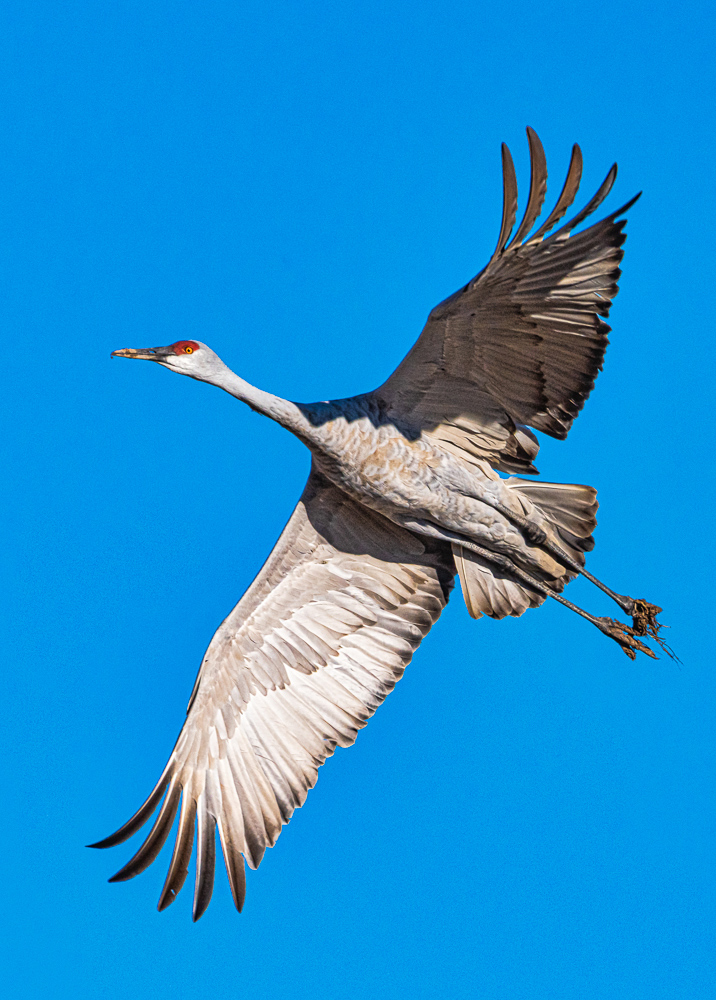
Challenge #3
Also at Bosque del Apache, I captured a moody landscape at daybreak which contained hundreds of different waterfowl. What I captured is exactly what I planned, as I often try to include wildlife in my landscapes, and refer to them as “Living Landscapes”. Taken with a Sony 135mm f1.8 GM lens mounted on my handheld Sony camera, the image is crisp and full of life.
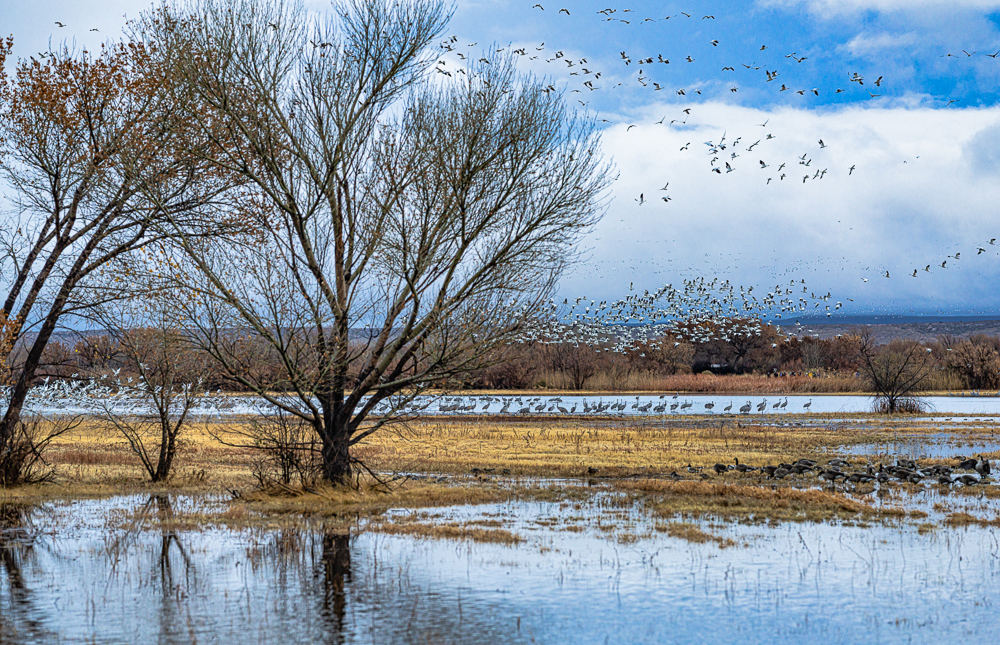
As I often do, I studied this image some months later to see how it could be improved. That’s when I realized that if I had used my 200-600 zoom lens I would have gotten a more striking image. But, it was too late. Or was it?
The Solution
You guessed it. Crop the heck out of it!
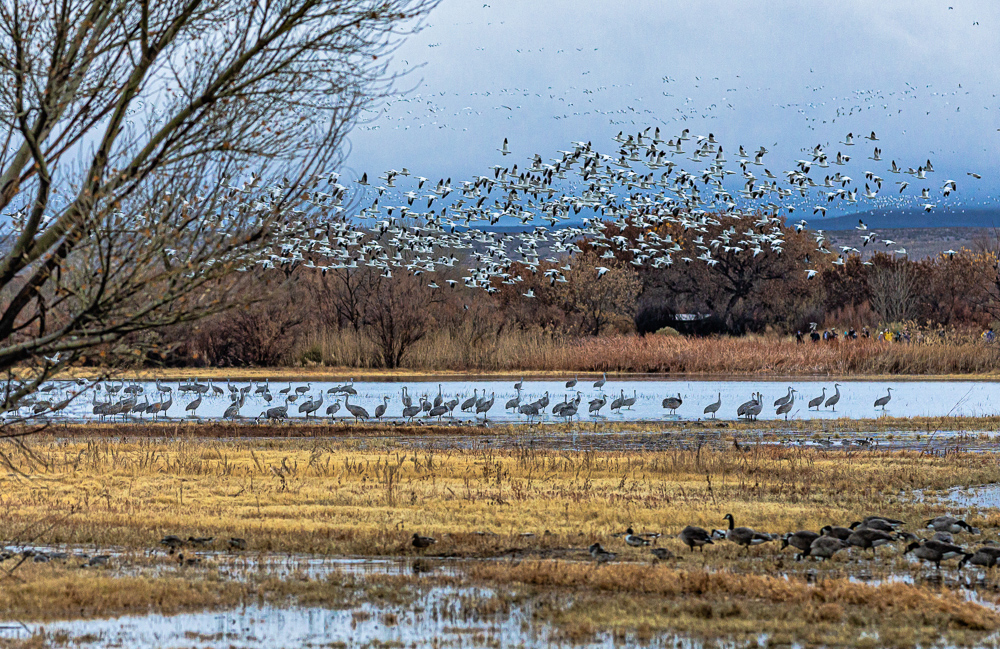
Challenge #4
The advantages of high resolution, low noise, and high dynamic range are easy to see. Observing the output of improved color accuracy may be measurable in the laboratory, but the differences are difficult to confirm visually. The challenge is to find a subject that has a range of different colors with hues that go from vibrant to “washed out” to see how such an array is handled by a camera that claims higher color accuracy.
The Solution
One of the few times that I was impressed by the Sony A7r M4’s ability to record slight differences in colors and hues resulted from an exposure that I almost didn’t make because I didn’t think that the image could reproduce all the subtleties. The following image captures a number of brightly colored butterflies at a feeding dish filled with sugary fruit. The fruit was quickly drying out in the warm air. If you consider how strong the reds are in fresh-cut watermelon and strawberries, and also how washed out those reds become after drying out, you appreciate how difficult it is to accurately reproduce that in one image. This image isn’t particularly artistic or appetizing. But, it does make me feel confident that the color quality of my future images will lead to better image-making.

Conclusions & Realizations
Since the beginning of Digital Photography, I have been one of those who eagerly looked forward to each new advanced and more capable camera. My wife and I always joked that each new camera that I bought was the penultimate camera and that the next camera after that would be my last. This never-ending quest for higher image quality was every bit as much mine as it was the camera industries.
Yet, I could be quite satisfied if I never went beyond what I have now. The new 150MP Phase One camera doesn’t excite me, and not just because I can’t justify the expense. Other than size, the Sony sensor used for this camera has the same characteristics as the A7r M4 61 MP sensor with exactly the same photo-site size. The basic difference is that it’s two and a half times as big. I don’t need bigger. I just need a reasonable number of pixels to spare in a highly portable and fast handling camera, with a wide variety of lenses to choose from in the $500 to $2,500 range. That’s what I currently have.
Nevertheless, I predict that the major camera companies will continue to make improvements in camera IQ at least through this decade. And some photographers will continue to hunger for the latest “New and Improved” offerings. But, I won’t be among them. That’s not to say that I wouldn’t be interested in something like an A-6500 size interchangeable lens camera with a 40 MP C-size sensor that can capture wildlife and action scenes at 20 fps with present IQ levels. That is if it becomes available before I hang up my hiking shoes.
Part 3 of this series on IQ will cover new lens formulations and how their higher sharpness, better light transmission, greater color accuracy, and higher levels of correction enable new cameras like the Sony A7r M4 to achieve their full capability.
Harvey Stearn
July 2020
Sedona, AZ
To see the scope and essence of Harvey Stearn's photographic art please visit www.CameraStops.com. Mr. Stearn began photographing Western landscapes and wildlife at the age of 13, spent 50 years pursuing his passion in the field and in the darkroom before fully converting to digital photography in 2002. He developed color prints as well as monochrome, but switched over to digital capture and editing in 2002. Though he was a top executive for two large scale land development and home building corporations, he always found time for his fine art photography which won many awards. His work was exhibited in art museums in Southern California and Arizona, and was also featured in billboard advertisements and published in magazines. Mr. Stearn served on the California Arts Council for nine years, including two years as Chairman and another two as Vice Chairman. In addition, he was the founding Chairman of the John Wayne Airport Arts Commission in Orange County, California. Mr. Stearn’s work was sold through Arizona galleries for 15 years. In recent years he wrote 33 illustrated articles for PhotoPXL.com and 14 articles for Luminous-Landscape.com. In 2013 he published a book entitled “In Search of the Old West” which has been widely acclaimed. He was a guest lecturer on photography on a cruise ship visiting Chile, Argentina, Uruguay and the Falkland Islands. His work was among the top 100 images printed in NANPA's Showcase publications in 2019 and 2020. Images have been edited and selected for two new books on Landscape photography which will be published in late 2024 and early 2025.






